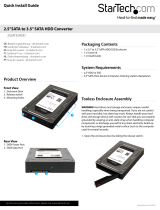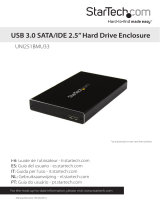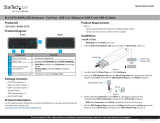Page is loading ...

Instruction manual
DE: Bedienungsanleitung - de.startech.com
FR: Guide de l'utilisateur - fr.startech.com
ES: Guía del usuario - es.startech.com
IT: Guida per l'uso - it.startech.com
NL: Gebruiksaanwijzing - nl.startech.com
PT: Guia do usuário - pt.startech.com
Manual Revision: 10/22/2015
For the latest information, technical specications, and support for
this product, please visit www.startech.com/USB312SAT3CB.
Packaging contents
• 1 x USB 3.1 to SATA 2.5 in. HDD adapter cable
• 1 x quick start guide
System requirements
• USB-enabled computer system with an available USB port
• 2.5 in. SATA drive
Note: To obtain the maximum USB throughput, you must use a
computer with a USB 3.1 Gen 2 port.
Supported operating systems are subject to change. For the latest
requirements, please visit www.startech.com/USB312SAT3CB.
USB312SAT3CB
USB 3.1 (10 Gbps) adapter cable for SATA drives
*actual product may vary from photos
Product overview
USB 3.1 connector
SATA connector for
2.5 in. HDD or SSD
Install the hardware
Warning! Hard drives and storage enclosures should be handled
carefully, especially when they’re transported. If you’re not careful
with your drives, you may lose data as a result. Always handle
storage devices with caution. Make sure that you’re properly
grounded by wearing an anti-static strap when you install any
computer component. If an anti-static strap isn’t available, touch a
large grounded metal surface (for example, the computer case) for
several seconds to discharge any built-up static electricity.
Note: The USB312SAT3CB adapter cable only works with 2.5 in.
HDD (hard drives) and SSD (solid state drives), because 3.5 in. HDDs
and optical drives require 12V of power and the adapter cable only
provides 5V of power.
1. Connect the SATA connector on the HDD adapter cable to the
SATA receptacle on your 2.5 in. SATA HDD or SDD.
2. Connect the USB 3.1 connector on the adapter cable to a USB port
on the host computer system.
About powering the drive
The drive adapter doesn’t require an external power supply, as it
receives enough power from the USB Bus that it’s connected to.
Connect the drive
After the cable is attached to a computer, the necessary software
automatically installs and the drive is accessible as though it were
installed internally in the system.
Before you use the drive, you must format it according to your
operating system requirements. To format your newly attached hard
drive or to create partitions, consult the documentation that came
with your operating system at the time of purchase.
Initialize the drive
If your computer doesn’t automatically recognize the drive, you need
to initialize and format it to the operating system.
If you use a computer that’s running Windows® 2000, Windows® XP,
Windows Vista®, or Windows 7, do the following:
1. Depending on the OS version that you’re running, do one of the
following:
• On your desktop, right-click My Computer.
• On your desktop, right-click Computer.
2. Click Manage.
3. On the Computer Management screen, click Disk Management.
4. A dialog window appears and asks you to initialize the hard drive.
Depending on the version of Windows that you’re running, you
have the option to create either an MBR or a GPT disk.
Note: GPT (GUID partition) is required for hard drives larger than 2
TB but GPT isn’t compatible with some earlier versions of operating

FCC Compliance Statement
This equipment has been tested and found to comply with the limits for a Class B digital device, pursuant to part 15 of the FCC Rules. These limits are designed to provide reasonable protection against
harmful interference in a residential installation. This equipment generates, uses and can radiate radio frequency energy and, if not installed and used in accordance with the instructions, may cause
harmful interference to radio communications. However, there is no guarantee that interference will not occur in a particular installation. If this equipment does cause harmful interference to radio or
television reception, which can be determined by turning the equipment o and on, the user is encouraged to try to correct the interference by one or more of the following measures:
• Reorient or relocate the receiving antenna.
• Increase the separation between the equipment and receiver.
• Connect the equipment into an outlet on a circuit dierent from that to which the receiver is connected.
• Consult the dealer or an experienced radio/TV technician for help
This device complies with part 15 of the FCC Rules. Operation is subject to the following two conditions: (1) This device may not cause harmful interference, and (2) this device must accept any
interference received, including interference that may cause undesired operation. Changes or modications not expressly approved by StarTech.com could void the user’s authority to operate the
equipment.
Use of Trademarks, Registered Trademarks, and other Protected Names and Symbols
This manual may make reference to trademarks, registered trademarks, and other protected names and/or symbols of third-party companies not related in any way to
StarTech.com. Where they occur these references are for illustrative purposes only and do not represent an endorsement of a product or service by StarTech.com, or an endorsement of the product(s)
to which this manual applies by the third-party company in question. Regardless of any direct acknowledgement elsewhere in the body of this document, StarTech.com hereby acknowledges that all
trademarks, registered trademarks, service marks, and other protected names and/or symbols contained in this manual and related documents are the property of their respective holders.
Technical Support
StarTech.com’s lifetime technical support is an integral part of our commitment to provide industry-leading solutions. If you ever need help with your product, visit www.startech.com/support and
access our comprehensive selection of online tools, documentation, and downloads.
For the latest drivers/software, please visit www.startech.com/downloads
Warranty Information
This product is backed by a two-year warranty.
StarTech.com warrants its products against defects in materials and workmanship for the periods noted, following the initial date of purchase. During this period, the products may be returned for
repair, or replacement with equivalent products at our discretion. The warranty covers parts and labor costs only. StarTech.com does not warrant its products from defects or damages arising from
misuse, abuse, alteration, or normal wear and tear.
Limitation of Liability
In no event shall the liability of StarTech.com Ltd. and StarTech.com USA LLP (or their ocers, directors, employees or agents) for any damages (whether direct or indirect, special, punitive, incidental,
consequential, or otherwise), loss of prots, loss of business, or any pecuniary loss, arising out of or related to the use of the product exceed the actual price paid for the product. Some states do not
allow the exclusion or limitation of incidental or consequential damages. If such laws apply, the limitations or exclusions contained in this statement may not apply to you.
systems. MBR is supported by both earlier and later versions of
operating systems.
5. Locate the disk that is labeled Unallocated. To conrm that the
hard drive is the correct one, check the hard drive capacity.
6. Right-click the section of the window that says Unallocated and
click New Partition.
7. To initialize the drive in the format of your choice, complete the
on-screen instructions.
Disconnecting the drive
Disconnect the drive on a computer running a version
of Windows
1. In the task bar on your desktop, click the Safely remove Hardware
and Eject Media icon.
2. In the list that appears, click the device that you want to remove.
3. When the message appears indicating that it’s safe to remove the
device, disconnect the USB cable from the computer.
Note: If you remove the connected drive before you receive a
notication that it’s safe to do so, you could experience lost or
corrupt data on the drive.
Disconnect the drive on a computer running a version
of Mac OS
1. Close any windows that list the contents of the hard drive.
2. On your desktop, click the USB Storage icon and drag it onto the
Trash Can icon on your desktop.
3. Wait 5 seconds and then disconnect the cable.
/





